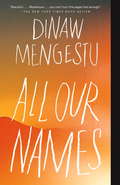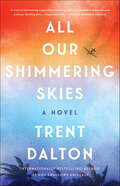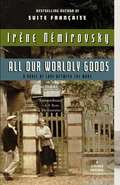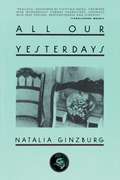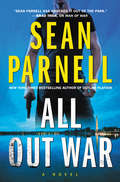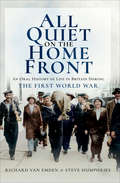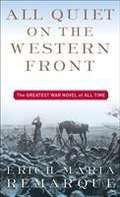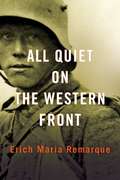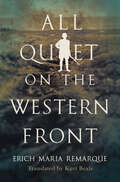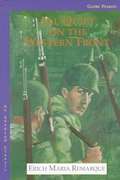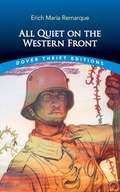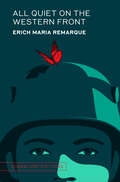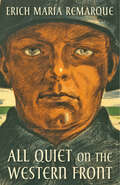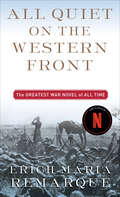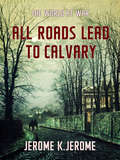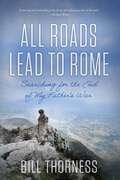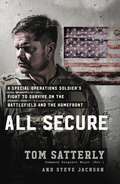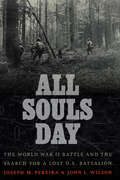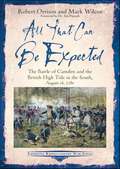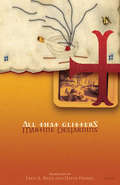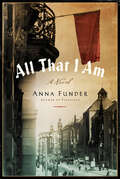- Table View
- List View
All Our Names
by Dinaw MengestuFrom acclaimed author Dinaw Mengestu, a recipient of the National Book Foundation's 5 Under 35 award, The New Yorker's 20 Under 40 award, and a 2012 MacArthur Foundation genius grant, comes an unforgettable love story about a searing affair between an American woman and an African man in 1970s America and an unflinching novel about the fragmentation of lives that straddle countries and histories. All Our Names is the story of two young men who come of age during an African revolution, drawn from the safe confines of the university campus into the intensifying clamor of the streets outside. But as the line between idealism and violence becomes increasingly blurred, the friends are driven apart--one into the deepest peril, as the movement gathers inexorable force, and the other into the safety of exile in the American Midwest. There, pretending to be an exchange student, he falls in love with a social worker and settles into small-town life. Yet this idyll is inescapably darkened by the secrets of his past: the acts he committed and the work he left unfinished. Most of all, he is haunted by the beloved friend he left behind, the charismatic leader who first guided him to revolution and then sacrificed everything to ensure his freedom. Elegiac, blazing with insights about the physical and emotional geographies that circumscribe our lives, All Our Names is a marvel of vision and tonal command. Writing within the grand tradition of Naipul, Greene, and Achebe, Mengestu gives us a political novel that is also a transfixing portrait of love and grace, of self-determination and the names we are given and the names we earn. From the Hardcover edition.
All Our Names
by Dinaw MengestuFrom acclaimed author Dinaw Mengestu, a recipient of the National Book Foundation&’s 5 Under 35 award, The New Yorker&’s 20 Under 40 award, and a 2012 MacArthur Foundation genius grant, comes an unforgettable love story about a searing affair between an American woman and an African man in 1970s America and an unflinching novel about the fragmentation of lives that straddle countries and histories. All Our Names is the story of two young men who come of age during an African revolution, drawn from the safe confines of the university campus into the intensifying clamor of the streets outside. But as the line between idealism and violence becomes increasingly blurred, the friends are driven apart—one into the deepest peril, as the movement gathers inexorable force, and the other into the safety of exile in the American Midwest. There, pretending to be an exchange student, he falls in love with a social worker and settles into small-town life. Yet this idyll is inescapably darkened by the secrets of his past: the acts he committed and the work he left unfinished. Most of all, he is haunted by the beloved friend he left behind, the charismatic leader who first guided him to revolution and then sacrificed everything to ensure his freedom. Elegiac, blazing with insights about the physical and emotional geographies that circumscribe our lives, All Our Names is a marvel of vision and tonal command. Writing within the grand tradition of Naipul, Greene, and Achebe, Mengestu gives us a political novel that is also a transfixing portrait of love and grace, of self-determination and the names we are given and the names we earn. This eBook edition includes a Reading Group Guide.
All Our Shimmering Skies: A Novel
by Trent DaltonFrom the internationally bestselling and beloved author of the critically acclaimed Boy Swallows Universe, a mesmerizing, uplifting novel of adventure and unlikely friendships in World War II Australia—calling to mind The Wizard of Oz as directed by Baz Luhrmann.Darwin, 1942. As Japanese bombs rain down on her hometown, newly orphaned Molly Hook looks to the skies and runs for her life. Inside a duffel bag, she carries a stone heart and a map that will lead her to Longcoat Bob, the deep-country sorcerer whom she believes cursed her family. Accompanying her are the most unlikely traveling companions: Greta, a razor-tongued actress, and Yukio, a Japanese fighter pilot who’s abandoned his post. With messages from the skies above to guide them towards treasure, but foes close on their trail, the trio will encounter the beauty and vastness of the Northern Territory and survive in ways they never thought possible. A story about the gifts that fall from the sky, curses we dig from the earth, and secrets we bury inside ourselves, Trent Dalton’s brilliantly imagined novel is an odyssey of true love and grave danger, of darkness and light, of bones and blue heavens. It is a love letter to Australia and an ode to the art of looking up—a buoyant and magical tale, filled to the brim with warmth, wit, and wonder.
All Our Worldly Goods
by Rene NemirovskyIn haunting ways, this gorgeous novel prefigures Irène Némirovsky's masterpieceSuite Française. Set in France between 1910 and 1940 and first published in France in 1947, five years after the author's death in Auschwitz, All Our Worldly Goods is a gripping story of war, family life and star-crossed lovers. Pierre and Agnes marry for love against the wishes of his parents and his grandfather, the tyrannical family patriarch. Their marriage provokes a family feud that cascades down the generations. This brilliant novel is full of drama, heartbreak, and the telling observations that have made Némirovsky's work so beloved and admired. Translated by Sandra Smith,Note: Does not use standard American spelling or punctuation.
All Our Yesterdays (Carcanet Fiction Ser.)
by Angus Davidson Natalia GinzburgFrom "one of the most distinguished writers of modern Italy” (New York Review of Books), a classic novel of society in the midst of a war.This powerful novel is set against the background of Italy from 1939 to 1944, from the anxious months before the country entered the war, through the war years, to the allied victory with its trailing wake of anxiety, disappointment, and grief. In the foreground are the members of two families. One is rich, the other is not. In All Our Yesterdays, as in all of Ms. Ginzburg’s novels, terrible things happen-suicide, murder, air raids, and bombings. But seemingly less overwhelming events, like a family quarrel, adultery, or a deception, are given equal space, as if to say that, to a victim, adultery and air raids can be equally maiming. All Our Yesterdays gives a sharp portrait of a society hungry for change, but betrayed by war.During the period described in the novel, Natalia Ginzburg was married to the writer Leone Ginzburg. Because of his underground activities, he was interned under Mussolini’s reign, along with his family, in a restricted area in the Abruzzi. When the Ginzburgs later moved to Rome, Leone was arrested and tortured by the fascists, and killed, leaving Natalia alone to raise her three children.Skyhorse Publishing, as well as our Arcade, Yucca, and Good Books imprints, are proud to publish a broad range of books for readers interested in fiction-novels, novellas, political and medical thrillers, comedy, satire, historical fiction, romance, erotic and love stories, mystery, classic literature, folklore and mythology, literary classics including Shakespeare, Dumas, Wilde, Cather, and much more. While not every title we publish becomes a New York Times bestseller or a national bestseller, we are committed to books on subjects that are sometimes overlooked and to authors whose work might not otherwise find a home.
All Out War: A Novel (Eric Steele #2)
by Sean Parnell“Eric Steele and author Sean Parnell are the real deal.”— Lee ChildSpecial operative Eric Steele, introduced in Man of War, is on the hunt for a formidable Russian terrorist in this high-intensity tale of international intrigue from the author of the New York Times bestselling memoir Outlaw Platoon.Badly injured while stopping a rogue agent from obtaining weapons of mass destruction, elite warrior Eric Steele is drawn back into service before he’s ready when unknown assailants break into his home near Pittsburgh, injuring his mother and stealing his father’s pistol.An Alpha—an elite soldier under the direct command of the president of the United States—Steele is hell-bent on finding the attackers and bringing them to justice. While tracking his foe, Steele discovers he’s become entangled in a far more sinister plan that’s already been set in motion. A terrorist named Zakayev, once locked away in a maximum-security prison in Russia, has escaped and joined forces with Hassan Sitta, a man who’s shown his prowess and ingenuity with a spectacular bomb planted somewhere in the Middle East that hasn’t been ignited—and no one can find. But that is only the beginning of a horrifying plan that, if it succeeds, will shatter international alliances and bring the world to the brink of war. Now, the hunted must turn the tables on the hunter—Steele must find a way to stay alive and stop Zakayev before innocent lives are lost.
All Quiet on the Home Front: An Oral History of Life in Britain During the First World War (Magna Large Print Ser.)
by Steve Humphries Richard van EmdenA &“fascinating&” look at hardship, heroism, and civilian life in England during the Great War (World War One Illustrated). The truth about the sacrifice and suffering among British civilians during World War I is rarely discussed. In this book, people who were there speak about experiences and events that have remained buried for decades. Their testimony shows the same candor and courage we have become accustomed to hearing from military veterans of this war. Those interviewed include a survivor of a Zeppelin raid in 1915; a Welsh munitions worker recruited as a girl; and a woman rescued from a bombed school after five days. There are also accounts of rural famine, bereavement, and the effects on families back home—and even the story of a woman who planned to kill her family to save them further suffering.
All Quiet on the Western Front
by Erich Maria Remarque A. W. WheenConsidered by many the greatest war novel of all time, All Quiet on the Western Front is Erich Maria Remarque’s masterpiece of the German experience during World War I. “I am young, I am twenty years old; yet I know nothing of life but despair, death, fear, and fatuous superficiality cast over an abyss of sorrow. . . .” This is the testament of Paul Bäumer, who enlists with his classmates in the German army during World War I. They become soldiers with youthful enthusiasm. But the world of duty, culture, and progress they had been taught breaks in pieces under the first bombardment in the trenches. Through years of vivid horror, Paul holds fast to a single vow: to fight against the principle of hate that meaninglessly pits young men of the same generation but different uniforms against one another . . . if only he can come out of the war alive.
All Quiet on the Western Front
by Erich Maria RemarquePaul Baumer enlisted with his classmates in the German army of World War I. Youthful, enthusiastic, they become soldiers. But despite what they have learned, they break into pieces under the first bombardment in the trenches. And as horrible war plods on year after year, Paul holds fast to a single vow: to fight against the principles of hate that meaninglessly pits young men of the same generation but different uniforms against each other--if only he can come out of the war alive. "The world has a great writer in Erich Maria Remarque. He is a craftsman of unquestionably first trank, a man who can bend language to his will. Whether he writes of men or of inanimate nature, his touch is sensitive, firm, and sure."
All Quiet on the Western Front
by Erich Maria RemarqueThe greatest war novel of all time rendered in a taut, muscular, and urgent new translation. An immediate sensation when it was published in 1929, Erich Maria Remarque’s All Quiet on the Western Front has sold more than twenty million copies worldwide since then, making it the best-selling German novel of all time. Its impact is indisputable: it has been adapted for film, television, and other media; has influenced all subsequent works of war literature; and has been taught in high school and college classes ever since. Until now, one translation—published in 1929, and very much a product of its time—has introduced most readers in English to Remarque’s wrenching portrait of the horrors of trench warfare. Now, nearly a century later, renowned translator Kurt Beals recaptures the energy and descriptive force of the German original, rendering Remarque’s distinctly terse, telegraphic prose into a contemporary idiom, conveying for a new generation the immediacy and intensity of this classic novel.
All Quiet on the Western Front
by Erich Maria RemarqueAll Quiet on the Western Front by Erich Maria Remarque is a harrowing and deeply human exploration of the brutal realities of war. Set against the backdrop of World War I, the novel follows Paul Bäumer, a young German soldier who, along with his comrades, is thrust into the violent chaos of the Western Front. Through Paul's eyes, Remarque vividly depicts the horrors of combat, the emotional toll of constant death, and the disillusionment that war brings to those who fight it. As the soldiers endure relentless bombardments, gas attacks, and the loss of friends, they grapple with a profound sense of alienation and despair. What begins as a patriotic call to arms for Paul and his peers quickly devolves into a desperate struggle for survival. The bond between soldiers becomes their only solace in an unforgiving world, and as the war drags on, the line between life and death blurs. With stark realism, Remarque captures the profound psychological trauma of war, stripping away any romanticism and exposing its dehumanizing effects. All Quiet on the Western Front is a timeless anti-war masterpiece that examines the deep emotional and physical scars left on those who are caught in the horrors of conflict. It&’s a poignant meditation on loss, the fragility of youth, and the tragic futility of war that will resonate with readers long after the final page is turned.
All Quiet on the Western Front (An Adapted Classic)
by Erich Maria Remarque Tony NapoliThis is the story of young German soldier, Paul Baümer's experiences fighting during "The Great War," World War I. The classic novel has been adapted to utilize shorter sentences and simpler vocabulary. Unusual words are footnoted and defined at the bottom of the pages. There are study questions at the end of the book. Illustrations have been described.
All Quiet on the Western Front (Dover Thrift Editions: Classic Novels)
by Erich Maria RemarqueA harrowing and unflinching novel about the brutal reality of World War I, All Quiet on the Western Front starkly contrasts the disillusionment and horror of war with a young German soldier's initial fervor and patriotism. As Paul Bäumer and his comrades grapple with relentless shelling, hunger, and the constant fear of death, their youthful idealism crumbles. Erich Maria Remarque's vivid narrative strips away the glory of war, exposing the senseless violence and loss and the psychological torment endured by a generation of soldiers. Arguably one of the most famous war novels of all the Modern era, this timeless classic presents a scathing critique of nationalism, a devastating indictment of war, and an enduring exploration of what it means to be human under extraordinary duress. The tale is so profoundly moving that it has been adapted into an Oscar-winning cinematic masterpiece not once, but twice.
All Quiet on the Western Front (Signature Editions)
by Erich Maria RemarqueI am young, I am twenty years old; yet I know nothing of life but despair, death, fear, and fatuous superficiality cast over an abyss of sorrow. . . This is the testament of Paul Bäumer, who enlists with his classmates in the German army during World War I. They become soldiers with youthful enthusiasm. But the world of duty, culture, and progress they had been taught breaks in pieces under the first bombardment in the trenches. Through years of vivid horror, Paul holds fast to a single vow: to fight against the principle of hate that meaninglessly pits young men of the same generation but different uniforms against one another . . . if only he can come out of the war alive.
All Quiet on the Western Front (Vintage Classics)
by Erich Maria RemarqueWidely acclaimed as the greatest war novel of all time, this classic tale of a young German soldier's harrowing experiences in the trenches of World War I is the basis for an Academy Award-winning film. With an introduction by bestselling author Sebastian Faulks. When twenty-year-old Paul Bäumer and his classmates enlist in the German army during World War I, they are full of youthful enthusiam. But the world of duty, culture, and progress they had been taught to believe in shatters under the first brutal bombardment in the trenches. Through the ensuing years of horror, Paul holds fast to a single vow: to fight against the principle of hate that meaninglessly pits young men of the same generation but different uniforms against one another. Erich Maria Remarque's classic novel not only portrays in vivid detail the combatants' physical and mental trauma, but dramatizes as well the tragic detachment from civilian life felt by many upon returning home. Remarque's stated intention--"to tell of a generation of men who, even though they may have escaped shells, were destroyed by the war"--remains as powerful and relevant as ever, a century after that conflict's end.
All Quiet on the Western Front: A Novel
by Erich Maria Remarque A. W. Wheen<P><P>*This textbook has been transcribed in UEB, formatted according to Braille textbook formats, proofread and corrected. <P><P> Considered by many the greatest war novel of all time, All Quiet on the Western Front is Erich Maria Remarque’s masterpiece of the German experience during World War I. “I am young, I am twenty years old; yet I know nothing of life but despair, death, fear, and fatuous superficiality cast over an abyss of sorrow. . . .” This is the testament of Paul Bäumer, who enlists with his classmates in the German army during World War I. They become soldiers with youthful enthusiasm. But the world of duty, culture, and progress they had been taught breaks in pieces under the first bombardment in the trenches. Through years of vivid horror, Paul holds fast to a single vow: to fight against the principle of hate that meaninglessly pits young men of the same generation but different uniforms against one another . . . if only he can come out of the war alive.
All Quiet on the Western Front: A Novel (All Quiet on the Western Front #1)
by Erich Maria Remarque Arthur Wesley WheenPaul Baumer enlisted with his classmates in the German army of World War I. <P><P>Youthful, enthusiastic, they become soldiers. <P>But despite what they have learned, they break into pieces under the first bombardment in the trenches. <P>And as horrible war plods on year after year, Paul holds fast to a single vow: to fight against the principles of hate that meaninglessly pits young men of the same generation but different uniforms against each other--if only he can come out of the war alive.
All Roads Lead to Calvary (The World At War)
by Jerome K. JeromeThe novel "All Roads Lead to Cavalry" offers an irreverent take on the social forces at play in England in the period leading up to and just following the outbreak of World War I. If you're interested in history but often find yourself bored by historical fiction, this funny, one-of-a-kind novel is for you. (Google)
All Roads Lead to Rome: Searching for the End of My Father's War
by Bill ThornessWhat happens when a seasoned journalist and travel writer takes on his most challenging assignment yet—crossing not just continents but also history—by retracing his father&’s steps on the battlefields of Italy in World War II? When a slim packet of his father&’s letters came to light after his mother&’s death, Bill Thorness began a quest to rediscover his father. Thorness traveled to the World War II battlefields where America&’s first team of commandos fought. The youngest son of one of those commandos, Thorness gained a sense of the horror his father had kept from his family while standing on the mountain where the First Special Service Force fought. Then, standing on a bridge in Rome, he reflected on the loss his father must have felt in not making it to the end of the campaign to liberate the Eternal City. In All Roads Lead to Rome Thorness considers his father&’s decisive moments in battle and beyond, and how he soldiered on as a disabled veteran through his life, raising a family and succumbing to an early death. Alternating between reimagined battle scenes and present-day travels, Thorness explores World War II and family history, the value and limits of memory, the attitudes of war, and our society&’s inadequate understanding and support of combat veterans, who may return with physical and emotional scars that change them deeply. Thorness steps into his father&’s shoes to revisit his story and finish that walk into Rome, weaving an account that is part travelogue, part history, and part memoir about the ravages of war.
All Secure: A Special Operations Soldier's Fight to Survive on the Battlefield and the Homefront
by Steve Jackson Tom SatterlyOne of the most highly regarded Tier One Delta Force operators in American military history shares his war stories and personal battle with PTSD.As a senior non-commissioned officer of Delta Force, the most elite and secretive special operations unit in the U.S. military, Command Sergeant Major Tom Satterly fought some of this country's most fearsome enemies. Over the course of twenty years and thousands of missions, he's fought desperately for his life, rescued hostages, killed and captured terrorist leaders, and seen his friends maimed and killed around him. All Secure is in part Tom's journey into a world so dark and dangerous that most Americans can't contemplate its existence. It recounts what it is like to be on the front lines with one of America's most highly trained warriors. As action-packed as any fiction thriller, All Secure is an insider's view of "The Unit." Tom is a legend even among other Tier One special operators. Yet the enemy that cost him three marriages, and ruined his health physically and psychologically, existed in his brain. It nearly led him to kill himself in 2014; but for the lifeline thrown to him by an extraordinary woman it might have ended there. Instead, they took on Satterly's most important mission-saving the lives of his brothers and sisters in arms who are killing themselves at a rate of more than twenty a day. Told through Satterly's firsthand experiences, it also weaves in the reasons-the bloodshed, the deaths, the intense moments of sheer terror, the survivor's guilt, depression, and substance abuse-for his career-long battle against the most insidious enemy of all: Post Traumatic Stress. With the help of his wife, he learned that by admitting his weaknesses and faults he sets an example for other combat veterans struggling to come home.
All Souls Day: The World War II Battle and the Search for a Lost U.S. Battalion
by Joseph M. Pereira John L. WilsonThe U.S. Army attacked three villages near the German-Belgium border, surprising the Germans who surrendered with little resistance. The German army regrouped and counterattacked. A brief but horrific battle ensued, and as the enemy pressed forward, the Americans retreated in haste, leaving behind their wounded and their dead. Discussion of this week-long conflict that began on All Souls Day, November 2, 1944, has been confined to officer training school, in part due to its heavy losses and ignominy. After the war the U.S. Army returned to the battlefield to bring home its fallen. To its dismay it found that many of these men had vanished. The disappearances were puzzling and for decades the U.S. government searched unsuccessfully for clues. After poring over now-declassified battlefield reports and interviewing family members, the authors reconstruct a spellbinding story of love and sacrifice, honor and bravery, as well as a portrait of the gnawing pain of families not knowing what became of their loved ones. Ultimately this work of history and in-depth contemporary journalism proffers a glimmer of light in the ongoing search.
All That Can Be Expected: The Battle of Camden and the British High Tide in the South, August 16, 1780 (Emerging Revolutionary War Series)
by Mark Wilcox Robert OrrisonA history and analysis of the 1780 South Carolina battle that marked the turning point for Great Britain in the American Revolutionary War. “An impressive work of collaborative historical research by historians Robert Orrison and Mark Wilcox, this is the newest title in the simply outstanding ‘Emerging Revolutionary War’ series from Savas Beatie and a welcome, unreservedly recommended pick.”—Midwest Book Review “They have done all that can be expected of them, we are outnumbered and outflanked,” explained Lt. Col. Benjamin Ford regarding the desperate situation his Marylanders faced on the disastrous day of August 16, 1780.Many historians consider the battle of Camden as the high tide of Great Britain’s prospects for victory in the American South. In the spring of 1780, British leadership focused their attention on conquering the Southern Colonies. Charleston capitulated, along with the bulk of the American army defending it, in May of 1780. After its fall, the British set up outposts across South Carolina’s backcountry to secure that colony before moving into North Carolina. In response, the Continental Congress sent Gen. Horatio Gates, the “hero of Saratoga,” to take over the Southern Department. Gates reorganized the forces there and named his field command “Grand Army,” whose core was a small contingent of experienced Continentals from Maryland and Delaware. The majority, however, was comprised of untested soldiers and newly recruited militia from Virginia and North Carolina. Soon after his arrival, Gates led his army south to confront the British near Camden, South Carolina. The mostly inexperienced American force found itself facing some of the best units of the British army under the command of one of its best generals, Charles Cornwallis. The result was an unmitigated disaster for the Americans with far-reaching consequences.In All That Can Be Expected: The Battle of Camden and the British High Tide in the South, August 16, 1780, historians Rob Orrison and Mark Wilcox set forth the events surrounding one of the worst American military defeats in United States history. Readers will also follow in the footsteps of American and British soldiers through the South Carolina backcountry on a narrative tour to help better understand this fascinating campaign of August 1780.
All That Glitters
by Catrin CollierCornish smuggler Devlin 'Devil' Varcoe braves winter weather and revenue men to fetch the contraband on which Porthinnis depends for survival. Drawn to Jenefer Trevanion, whose father finances the smuggling operation, Devlin is seduced by beautiful wild-child Tamara Gillis. When fire destroys her home, Jenefer is forced to work in the pilchard cellars. Meanwhile, craving Tamara for himself, Thomas Varcoe plots murder to rid himself of the brother he hates. Rejected by Devlin, a pregnant Tamara is pressured to marry Thomas. Finally recognising the love he never felt he deserved, Devlin is on his way home after successfully undertaking a secret mission when a once-in-a-lifetime storm faces him with a terrible choice.
All That Glitters
by David Homel Fred A. Reed Martine DesjardinsIn 1914, Simon Dulac enrolls in a Canadian contingent of military police, a perfect cover for his real ambition-to comb the battlefields of Europe unhindered, searching for legendary Templar treasure. There, Dulac encounters Nell, affecting and skilled, who has come to the trenches to practice suturing wounds. Together, haunted by the jealousy of their commanding officer, they pursue their desires.
All That I Am: A Novel
by Anna FunderAn award-winner “writes with grace and conviction about the intrusion of the political on the domestic and the thrill of falling in love over a cause” (New York Times Book Review).When eighteen-year-old Ruth Becker visits her cousin Dora in Munich in 1923, she meets the love of her life, the dashing young journalist Hans Wesemann, and eagerly joins in the heady activities of the militant political Left in Germany. Ten years later, Ruth and Hans are married and living in Berlin when Hitler is elected chancellor. Together with Dora and her lover, Ernst Toller, the celebrated poet and self-doubting revolutionary, the four become hunted outlaws overnight and are forced to flee to London. Inspired by the fearless Dora to breathtaking acts of courage, the friends risk betrayal and deceit as they dedicate themselves to a dangerous mission: to inform the British government of the very real Nazi threat to which it remains willfully blind.Gripping and inspiring, All that I Am is a masterful novel of the risks and sacrifices some people make for their beliefs, and of heroism hidden in the most unexpected places.“An intimate exploration of human connection and our responsibility to one another” —Colum McCann, National Book Award winning author of Let the Great World Spin“Moving and ambitious.” —Ann Patchett, New York Times bestselling author of Tom Lake“Enthralling.” —O, the Oprah Magazine“A literary work as suspenseful as the best thrillers.” —Booklist“A remarkable story told with clarity and precision . . . insight and literary grace.” —Rachel Cusk, The Guardian“This book is a wonder.” —Jonathan Mirsky, The Spectator“Imaginative, compassionate and convincing.” —Wall Street Journal

